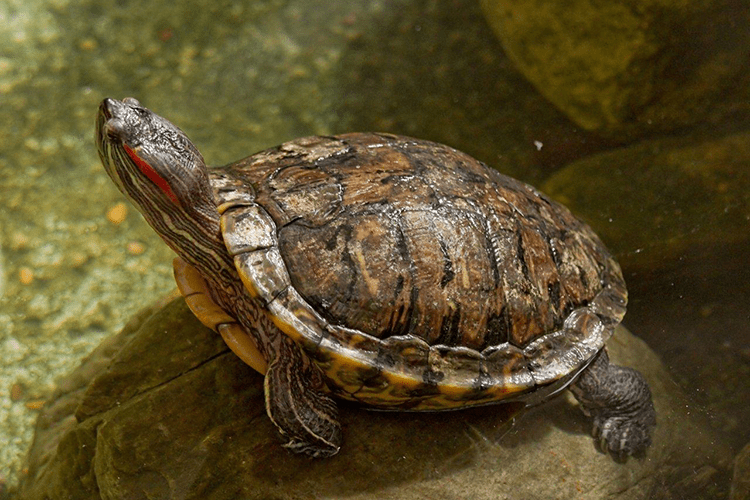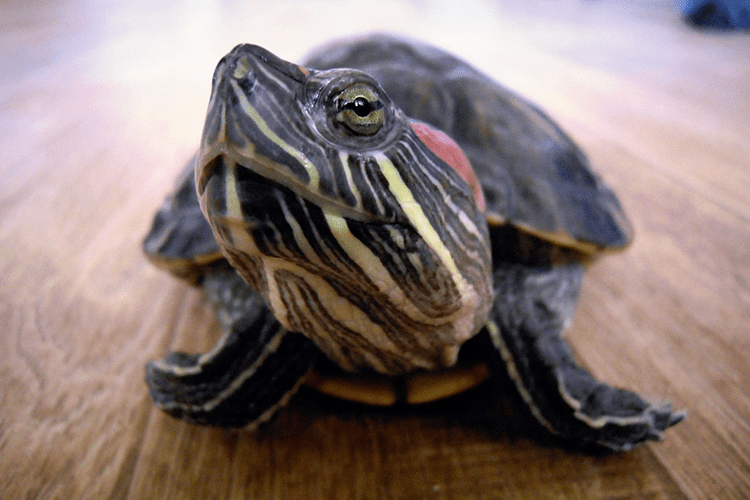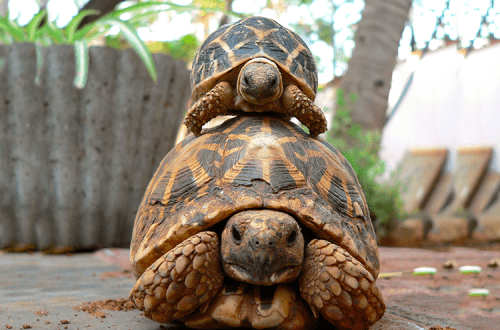
Pond slider
Red-eared turtles are aquatic, omnivorous pets, known for their beautiful pattern on the shell, funny red stripes in the ear area and unpretentiousness in maintenance. Red-eared turtles are long-lived: with proper care and maintenance, the life expectancy of turtles ranges from 20 to 50 years.
The red-eared turtle belongs to the family of freshwater turtles and is the most popular pet among pet reptile enthusiasts. The turtle owes its name to the red or orange stripes located in the ears and stretching from the eyes to the neck of the pet.
The upper part of the carapace (carapace) of the red-eared turtle is rounded and very smooth. In young, the carapace is bright green, but later it becomes yellow-brown or olive. Also, a peculiar pattern of yellow and dark lines appears on the carapace, which continues on the head and limbs of the turtle, giving it a very beautiful, unusual look. Interestingly, depending on the subspecies and habitats of turtles, the pattern may vary.
The underside of the carapace (plastron) also has a smooth texture. The plastron is yellowish in color, with dark stains and spots.
Many believe that the size of the shell can determine the age of the turtle. In practice, everything is quite approximate. The size of the shell depends not only on age, but also on the conditions of detention, because. with proper care and intensive feeding, red-eared turtles grow much faster.
The size of an adult red-eared turtle on average ranges from 25 to 30 cm, cubs are born only 2,5 cm long, but after a year they reach 5-7 cm in length. Mature individuals are turtles that have reached 10 cm in length (males) and 12,5 cm in length (females). The size of a turtle is determined by the length of its shell (from the front to the rear edge), without taking into account its curvature.
Gender can be determined in turtles over the age of 1 year, whose shell length is from 10 cm. As a rule, females are larger than males, their tail is shorter, and the cloaca is closer to the base of the tail than in males. Other identifying features can be the fact that in males the plastron is slightly concave inward, and their claws are larger, curved and longer than in females.
As a rule, red-eared turtles reach sexual maturity at the age of about 2-5 years with a carapace size of at least 10 cm for males and 12-13 for females. During mating games, the male swims up to the female, settles down opposite her, muzzle to muzzle, and quickly moves his front paws, as if vibrating them. In their natural habitat, the mating season for turtles is spring and early summer, but when kept at home, pets can create pairs all year round.

With proper care, the life expectancy of the red-eared turtle in captivity is 20-50 years, while in the wild they usually live no more than 20.
Despite the fact that red-eared turtles are rather unpretentious pets, they nevertheless require careful and reverent care. Unfortunately, many owners treat this issue irresponsibly and neglect the attributes that turtles really need, which is why a huge number of them get sick and die.
When starting a red-eared turtle, it should be understood that for its maintenance it is mandatory to purchase a spacious aquarium (from 150 liters), an island, a 100-watt water heater, a heating lamp, an ultraviolet lamp for aquatic turtles, a filter, a lamp and a thermometer.
All these attributes are really necessary for the pet, because. lack of space, for example, causes developmental disorders in turtles, and lack of ultraviolet light interferes with calcium absorption and destroys bones and shells.
Red-eared turtles are aquatic, however, they are not adapted to being in the water all the time, and they definitely need a piece of land where they can rest and warm up. Land should occupy 25% of the area of the aquarium, and its shore should be gentle so that the turtle can easily climb on it. Lamps are placed above the land so that light falls on the resting turtle. During the whole day (i.e. 10-12 hours) the lamps in the aquarium should be on.
The water level in the aquarium must exceed the width of the tortoise shell so that the pet can freely swim and roll over in the water. Only settled water should be used to fill the aquarium. Recommended water temperature: 20-25?С. Replacing the water in the aquarium should be done 1-2 times a week.
As neighbors for red-eared turtles, it is best to choose turtles of the same age and species. For all their friendly appearance, these pets can be quite aggressive, and their neighbors must be able to fend for themselves. Under no circumstances should adult red-eared turtles and baby turtles be placed in the same aquarium.
Soil and stones are not necessary for the turtle, they are mainly used for aquarium decoration. It is very important to choose a decor of such a size that the turtle cannot swallow it.
Red-eared turtles are omnivorous pets, their daily diet is quite diverse and includes both prepared food and vegetables, plants, insects, shrimp, etc.

In the wild, the homeland of red-eared turtles is the southeastern part of the United States, however, unpretentious reptiles are also found in North America, Europe, Asia and South Africa. The wide distribution area is explained by the fact that the red-eared turtles are adapted to life in any slow-flowing water bodies and, being omnivores, are not so demanding on food.
Red-eared turtles were first mentioned in the 16th century: Spanish colonialists wrote about them in research notes about Peru. Since that time, the red-eared turtles were attributed to one or the other subspecies, which greatly confused amphibian lovers, and only in 1986 was it approved as a representative of the genus Trachemys.
Today, red-eared turtles are the most popular pet turtles in the world.
Turtles are one of the oldest inhabitants of the planet, which appeared on earth much earlier than birds.
Red-eared turtles do not have gills, like fish, and cannot breathe underwater: they have to rise to the surface of the water for oxygen.
In Germany, red-eared turtles are also called red-cheeked.
Red-eared turtles have excellent eyesight. They can distinguish colors and see perfectly at a distance of 40 m!





